The Physical Archive and the Conservation Challenge
Most of the original documents in this exhibition were written more than 300 years ago. The clerks of the Archdeaconry court used rag paper of good quality which, unlike our modern wood pulp papers, will survive for many centuries in the right conditions.
Unfortunately, over the years the archive suffered from damp, dirt, poor storage, and even the attacks of insects and mice. Some documents became fragile and could not be handled without falling apart. Others incurred localised damage, losing corners and sections of text. When the papers arrived at the University, it was clear that major repairs were necessary before they could be fully accessible to researchers.
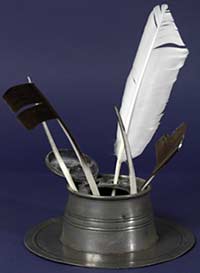
Quill pens made from goose feathers (Private collection)
The conservation of fragile papers and parchment requires many skills, and new techniques are constantly being developed. The primary aim of the conservators is to ensure the physical safety of the material, both by repair of previous damage and by precautions against further deterioration.
Conservation staff analyse the damage and repair the documents using a variety of methods. In some cases, traditional hand-repair techniques involve painstaking work on each page over many hours. Advances in leaf-casting technology in recent years allows some papers to be repaired more rapidly, stabilising and strengthening the documents and filling in missing portions with fresh paper pulp which is prepared to match the original paper. Most documents in the Archdeaconry archive are suitable for leaf casting methods.
The finished documents can safely be handled by readers and are returned in specialist acid-free packaging for storage in environmentally controlled conditions, safe for the future.
Many volumes and documents have been treated over the decades, but an enormous problem still remains. In 1993 a grant from the National Manuscripts Conservation Trust provided the opportunity for large-scale repairs. This successful pilot has formed the basis for a more ambitious project, supported by the Heritage Lottery Fund. This will ensure repair and preservation of the Presentment Bills, a key series in the history of the seventeenth-century Archdeaconry. As illustrated in this case, there are other physical problems in different parts of the archive, and conservation programmes will be needed for many years to come.
Creating the Records
The date is 21st October 1621.
Hugh Parke, a clerk who has worked in the Registry of the Archdeaconry of Nottingham since around 1608, is writing out the presentment made by the churchwardens of Barton in Farbis. When he has finished copying out all the faults which they report, they will make an oath confirming that it is correct, and then sign or mark their names.
When Parke has finished writing the Presentment Bill, he will file it by adding it to the top of a pile of ones he or his colleague has already dealt with. The pile is created by pushing documents onto a metal spike.
Eventually, all the Presentment Bills from September 1621 to March 1622 are lifted from the spike and tied together with a piece of string or leather passed through the spike hole.
These photographs of bundles of later Presentment Bills show how they were originally tied together. The dirt which has accumulated over hundreds of years on the cover of the bundle can clearly be seen.
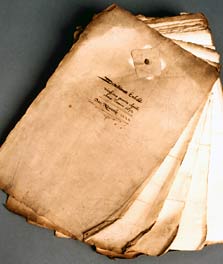
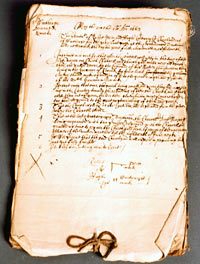
Presentment Bill bundles, Newark deanery. Photographs of AN/PB 329 and AN/PB 330 before conservation treatment
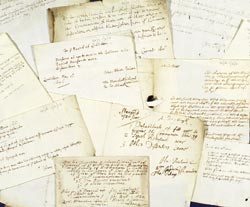
Nottinghamshire returns for the Compton Census, 1676. Selection [AN/M 1/3/1-167]
Bundles of papers which were sent in to the Archdeaconry court show a variety of physical appearance. In 1676, for instance, when Bishop Compton of London ordered a national survey of parishes, the local correspondents were not given a standard form to fill in, but used whatever paper (or parchment in the case of East Bridgford) came to hand. Fortunately, these fascinating returns of local people have survived in good condition. Figures were supplied of the number of inhabitants of each parish, divided into three groups: those attending church regularly, Roman Catholics, and dissenters.
The formulaic nature of legal documents or certificates meant that they could be printed as forms, and simply filled in with the details of a particular case. This method was used in particular in the Induction Mandates, where instructions were given by the Archbishop of York for the induction of a particular clergyman into a rectory or vicarage.
Some other examples can be found in the Penances series. A penance to be carried out by John and Elizabeth Pacy in 1680 (AN/PN 362/131), is unusual because the offence, the 'crime of fornication … before marriage', is specified in the printed part of the document. Clearly, enough people were brought before the court for this offence to justify the printing.
Bundles and Pins
Original sharp fastenings can present an unexpected hazard for the modern reader. But the principal reason they are removed from archives is the fact that metal pins are liable to rust when exposed to damp or humidity, causing staining and corroding of both paper and parchment. They are therefore removed when new collections are processed. In addition, most conservation processes require each page to be handled separately, so documents need to be detached from each other, even if no rust damage is present.
Originally, Presentment Bills were tied together in bundles. Today, they are unpicked to enable safe handling of individual documents. A sample of these tags and thongs has been assembled as a record of the physical history of the archive. The tags are made from parchment, and most of the thongs from string, sometimes with metal at the ends to keep them from fraying. The top thong in the third picture below is made of leather.
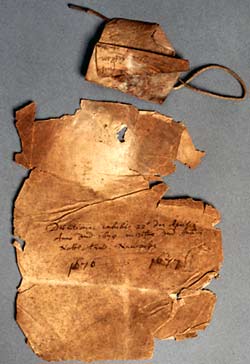
Photograph of front cover and parchment tag, removed from a bundle of Presentment Bills, Newark deanery, 1675 [AN/PB 330]
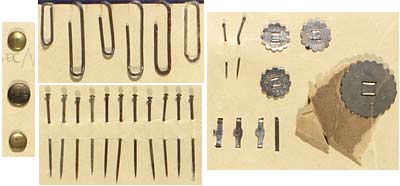
Metal objects removed from documents from Ne 6 EC and AN/PB 343
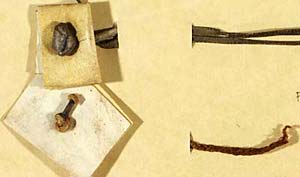
Tags and thongs removed from Presentment Bill bundles [AN/PB 304]
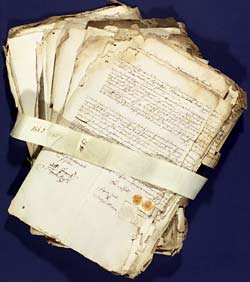
Bundle of Marriage Bonds, 1662 [AN/MB 58]
Marriage Bonds
Marriage bonds and allegations, which were in effect applications to marry by special licence, have in recent years been the most heavily used documents in the Archdeaconry archive, because of their great value for family historians.
In fact, very few researchers ever consult the originals, as for most years they can refer to published extracts of the principal details - names, dates and parishes. Indexing of the remainder of the series is now almost complete, thanks to the support of volunteers.
The original bundles of Marriage Bonds are physically quite similar to other series within the Archdeaconry archive, and in places share the problem of severe physical damage which prevents handling. Some papers in the bundle shown here have already lost parts of their text.
The year 1662 is written on the parchment wrapper for the bundle. In modern terms this describes a twelve month period from 25 March 1662 to 24 March 1663, as the practice of dating the new year from 1 January did not begin in England until 1752. In cataloguing, archivists need to understand historical dating methods, so that historians can locate the relevant records.
Presentment Bills
Sixteenth and seventeent century Presentment Bills have been the focus of a recent conservation project supported by the Heritage Lottery Fund. The photograph below shows the damage that had occurred to one original bundle. It was impossible for archivists or researchers to handle this bundle until it had been fully conserved.
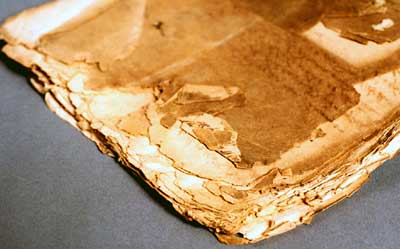
Fragile edges on an original bundle of Presentment Bills, 1675 [AN/PB 330]
The documents shown below are in better condition, as they are not mouldy or in immediate danger of crumbling. However, the Presentment Bills at the top and bottom of the bundle have been crumpled and torn, and are covered with a thick layer of dirt. The very first item in the bundle has been exposed to too much light, and is brittle.
In striking contrast, the documents in the middle of the bundle, which have been protected from exposure, are clean, flat and in excellent condition. The principal treatment required for this bundle is the cleaning and gentle flattening of the dirty and torn items, using a special conservation-quality soft cleaning pad.
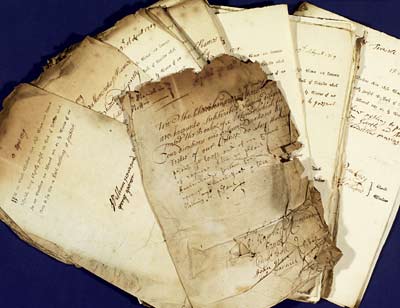
Selection from a bundle of Presentment Bills, Nottingham deanery, Easter 1719 [AN/PB 309/690-745]
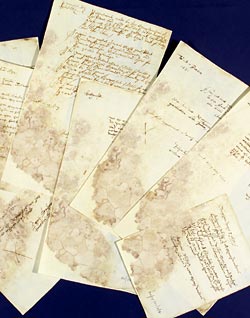
Selection of recently conserved Presentment Bills, Retford deanery, Easter 1632 [AN/PB 340/5/1-52]
One of the first principles of modern conservation is to use techniques which are reversible, and which use materials similar to the original items.
Some Presentment Bill bundles were conserved many years ago. Many of these documents have been backed by, or sandwiched between, a heat-sealed material which cannot now be removed. The documents have then been bound together. Although they are now safe to handle, individual Presentment Bills cannot be isolated, for instance, for display or digitisation purposes, without the whole binding being taken apart.
The marbled, pinkish colouring on the edges of some of the conserved items on the right show where the documents used to be very fragile. The colouring is caused by mould, which weakened the paper. If the documents had been handled carelessly, whole sections of the paper might have crumbled away, taking the text with them. Cleaning and conservation work on this bundle is now complete, and the Presentment Bills are available for researchers to use.
Act Books
Fragile volumes present particular problems for conservators, archivists and researchers. The Act Books, which record the proceedings of the court in session, are central to our understanding of the Archdeaconry's work and influence.
In the example shown below, parchment leaves from a discarded medieval manuscript work have given protection to the text block. Such parchment fragments are often found in late sixteenth-century works. They are studied in their own right, and sometimes provide information about rare texts. They are often themselves in need of specialist repair.
This particular manuscript appears to be a Latin treatise on the night sky, written in a twelfth century hand. It lists the appearance and composition of constellations of stars. Under the heading 'Perseus', it describes how the constellation shows the Greek hero holding the head of the Gorgon in his left hand.
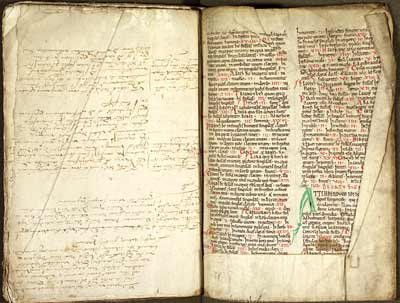
Act Book 1576-1578 [AN/A 2]
Citations
The current conservation work on the Presentment Bills has been given priority because these papers record the first stage in the Archdeaconry's efforts to monitor and direct local communities. Other series describe later points in the process.
The Citations record the summons of individuals to a particular session of the court. The documents, issued by the court, bear the seal of the Archdeacon, secured by a paper wafer. This adds to the conservation challenge. In fact, the great majority of these seals have been lost over the centuries.
The bundle shown below is still tied together with a leather thong. This makes it very difficult to read documents in the middle of the bundle without putting strain on those at the front. Additionally, the paper is degraded at the edges. This item cannot be made accessible to researchers until it is protected against further damage.
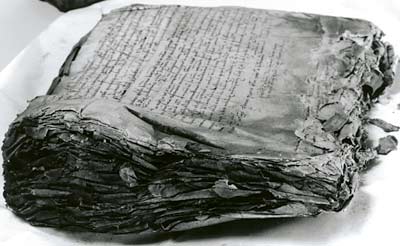
Original bundle of citations, 1613 [AN/C 123]
Next: Back to all online exhibitions